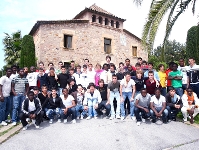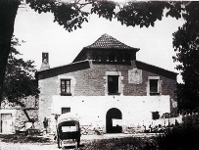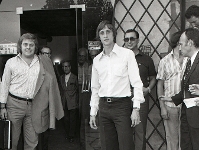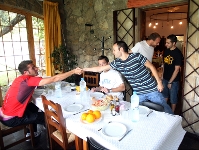FCBARCELONA.CAT
Main menu

Content menu
Football
08.10.2009 12:26
La Masia, 30 years of residence
Aleix Santacana
La Masia de Can Planes, located next to the Camp Nou, is the birthplace of the club youth system began. It was opened on October 20, 1979 as a players’ residence and 30 years later it is still developing sportspeople, and more importantly, human bein
From Thursday, FC Barcelona’s website will be publishing the memories and experiences of people who lived there over these 30 years. Josep Boada, Guillermo Amor, Francesc "Tito" Vilanova, Aureli Altimira, Sergi Barjuan, Víctor Valdés and Pedro Rodríguez will all be telling us about their days in this important part of the FC Barcelona heritage.
Dreams and frustrations
 La
Masia, catalogued as a historic-artistic building by the Barcelona Council, has witnessed three
decades of dreams coming true, but also years of frustrated hopes and desires. Its management has
successfully promoted a blend of sports and personal training for all of its residents.
La
Masia, catalogued as a historic-artistic building by the Barcelona Council, has witnessed three
decades of dreams coming true, but also years of frustrated hopes and desires. Its management has
successfully promoted a blend of sports and personal training for all of its residents.
Workshop, offices and residence
 La Masia is an old country residence built in 1702. Barça first used it as a
workshop for building the original scale models of the Camp Nou. After the stadium opened, La Masia
was closed, it serving no direct purpose.
La Masia is an old country residence built in 1702. Barça first used it as a
workshop for building the original scale models of the Camp Nou. After the stadium opened, La Masia
was closed, it serving no direct purpose.
 Under
Enric Llaudet’s presidency, the building was remodelled and extended and became the club
headquarters, inaugurated on September 26, 1966. But the club was expanding and new secretaries
were created, meaning the La Masia was too small a site, and once again fell into disuse. It was
Josep Lluís Núñez and his board who came up with a new use for it. From October 20, 1979, La Masia
became a home for the youth players that were from outside of Barcelona.
Under
Enric Llaudet’s presidency, the building was remodelled and extended and became the club
headquarters, inaugurated on September 26, 1966. But the club was expanding and new secretaries
were created, meaning the La Masia was too small a site, and once again fell into disuse. It was
Josep Lluís Núñez and his board who came up with a new use for it. From October 20, 1979, La Masia
became a home for the youth players that were from outside of Barcelona.
From 15 to 60 residents
 At
first, La Masia housed 15 residents, all living on the top floor. But times were changing, and FC
Barcelona now has two residences for youth players. There is La Masia, with dormitories, bathrooms,
study rooms, a dining room and kitchen, and a new residence in the Camp Nou, known as La Masia 2.
At
first, La Masia housed 15 residents, all living on the top floor. But times were changing, and FC
Barcelona now has two residences for youth players. There is La Masia, with dormitories, bathrooms,
study rooms, a dining room and kitchen, and a new residence in the Camp Nou, known as La Masia 2.
This season, La Masia has a total of 56 residents. 10 reside in the actual Masia and the others sleep in the stadium, on two floors with three-bed rooms.

To view this content you need the latest version of the Flash Player
Multicultural residents
The players living in La Masia are no longer just from Catalonia, or even the rest of Spain. There
are also youngsters from as far afield as Cameroon, Senegal, Georgia, Hungary and Holland. And it
is not just footballing hopefuls that live there. There are also players of others sports –
eleven young basketball players and one roller hockey player live on the FC Barcelona grounds.



